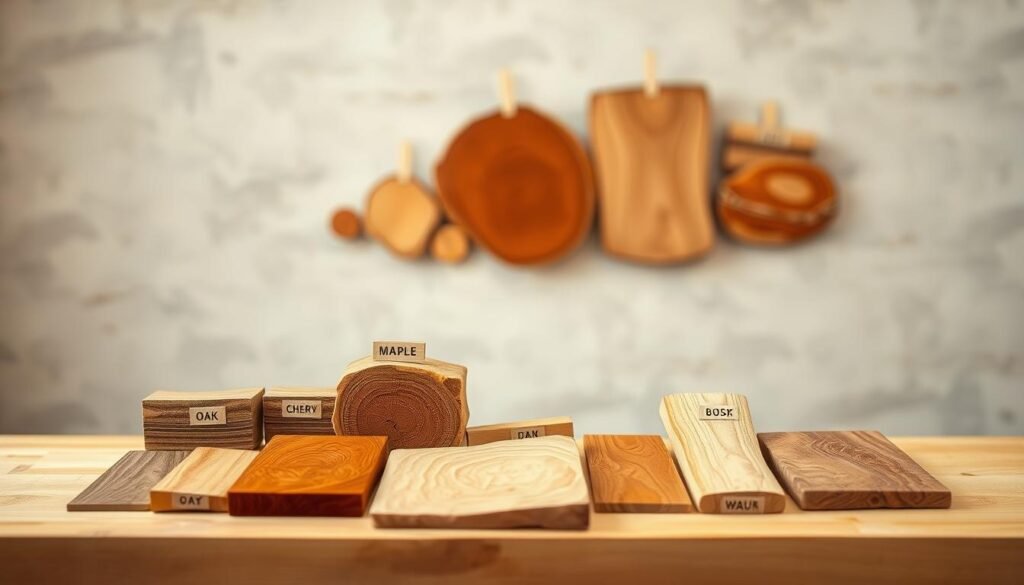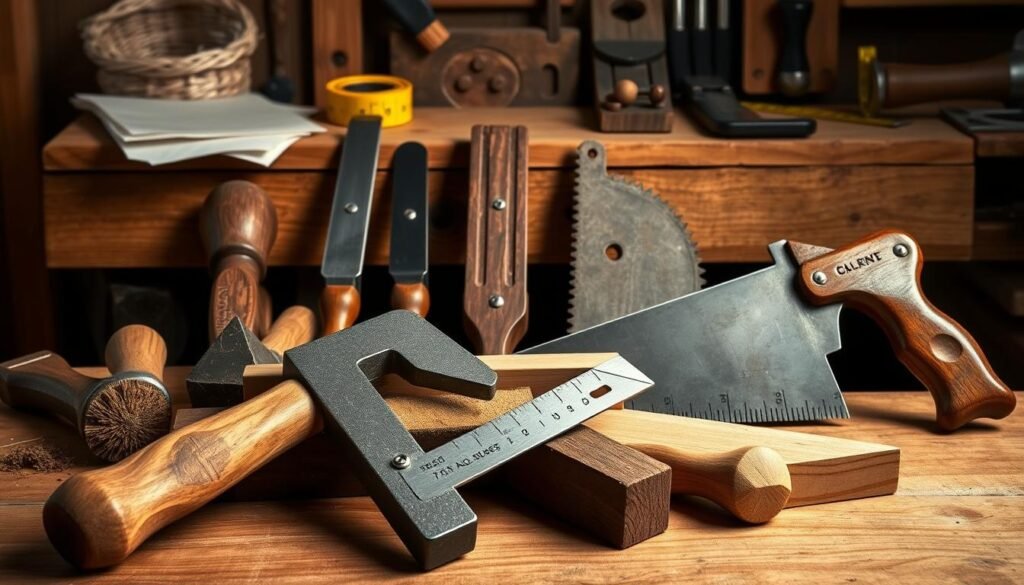Woodworking fans are always on the lookout for that special trick. A woodworking tip that experts love can really change your game.
Using simple yet powerful woodworking hacks can lead to amazing results. Whether you’re just starting or have years of experience, learning DIY woodworking tricks is key.
Finding woodworking secrets can change how you tackle woodworking projects. With the right advice, you can unlock your craft’s full power and improve your woodworking skills.
The Secret That Professional Woodworkers Don’t Share
Experienced woodworkers know a secret that makes their projects stand out. It’s not just about learning woodworking techniques. It’s also about understanding the craft’s details.
One key woodworking tip and trick is grain alignment. Getting the wood grain right improves both durability and looks in any carpentry project. It’s a small detail that can greatly affect the final product’s quality.
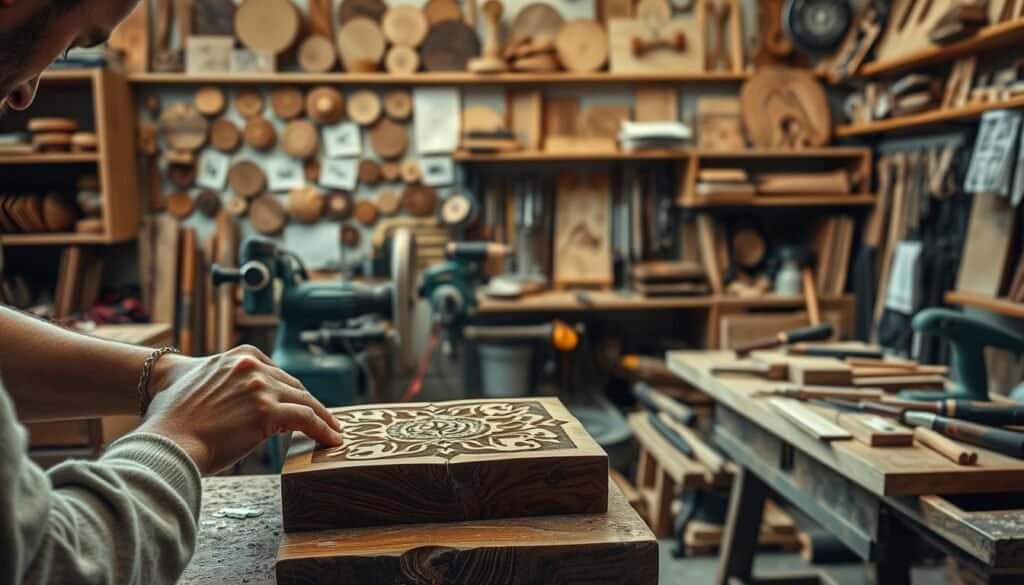
For beginners, mastering grain alignment might seem hard. But with practice and the right woodworking advice, it’s achievable. Making DIY tools homemade can also help get the grain alignment just right, boosting the project’s quality.
As you tackle more complex carpentry projects, grain alignment’s importance grows. It’s a secret known by pros, making their work unique. By using this technique, woodworkers can make sure their projects last long.
The Little-Known Woodworking Tip That Changes Everything: Proper Wood Grain Alignment
Wood grain alignment is key to great woodworking. It makes your projects stable and look good. Whether it’s a small project or a big DIY idea, knowing about grain alignment helps a lot.

Learning to read wood grain patterns is vital. The pattern shows where the wood fibers run. This impacts your project’s strength, durability, and look. Knowing how to read these patterns helps you plan better and make your project look and work well.
Reading Grain Patterns Like a Pro
To read grain patterns well, look at the lines on the wood’s surface. These lines show the wood fibers’ direction. Remember, different woods have different patterns, and some are harder to read. Tools like a grain viewer or magnifying glass can help see the pattern clearly.
The Science Behind Wood Fiber Orientation
Wood fiber orientation comes from how trees grow. The fibers run with the tree’s growth direction. This affects the wood’s strength and stability. Cutting with the grain helps avoid warping or cracking, keeping your project stable.
Using proper wood grain alignment improves your woodworking. It makes your projects not just look good but also last long. As you work on more projects, this skill will become easier. You’ll be ready to take on more complex DIY projects with confidence.
Transforming Your Project Planning Process
Good project planning in woodworking is more than picking the right materials. It’s about understanding wood grain alignment. Knowing the grain direction helps avoid warping or cracking, making sure your projects look great.
When making woodworking plans, think about the lumber’s grain orientation. This affects the project’s stability and look, whether it’s tools or DIY projects.
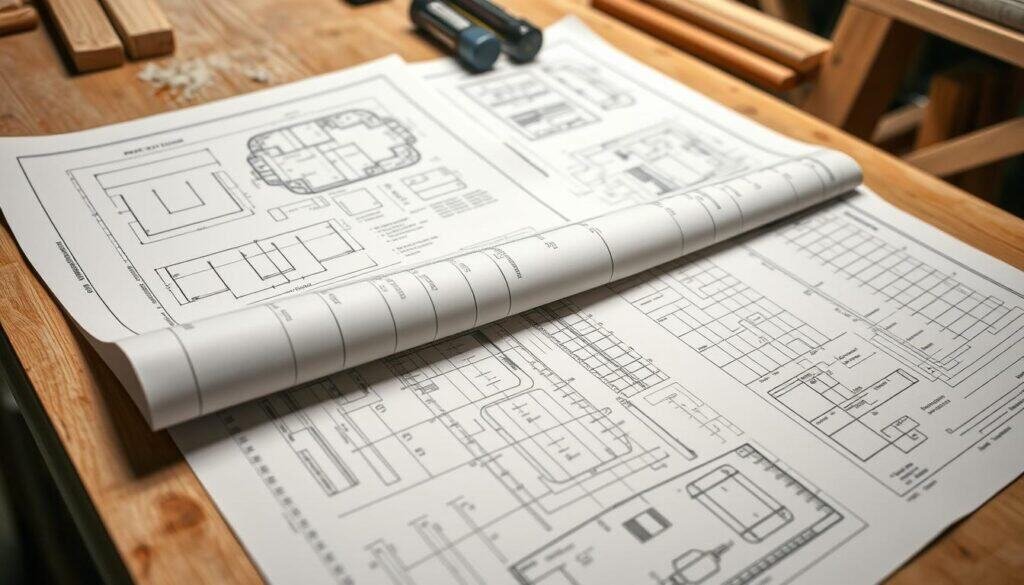
Looking to get better at planning? There are many resources with grain-optimized plans. These plans help woodworkers achieve top-notch results. Using these resources is a great way to learn.
Adding grain alignment to your planning boosts your work’s quality and cuts down on waste. This method makes your projects look better and last longer.
Hand Tool Applications That Showcase This Technique
Hand tools are key in woodworking, giving woodworkers precision and control. They help in aligning wood grain accurately. This is vital for many woodworking projects.
Hand saws are essential for making cuts that follow the wood grain. This avoids splinters and ensures a smooth finish. For example, using a hand saw in DIY carpentry projects greatly improves the quality.
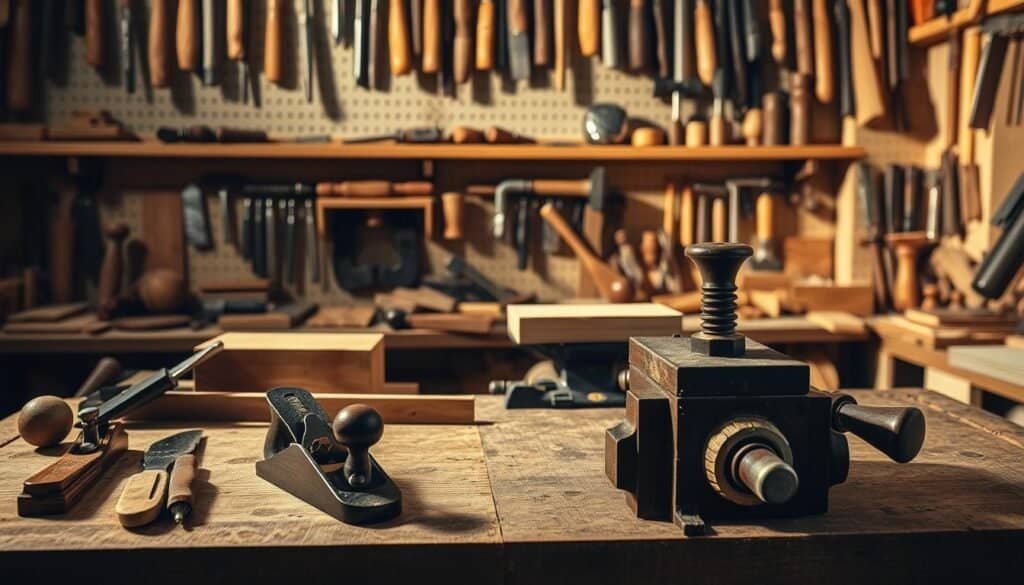
Chisels and hand planes are also important for fine-tuning wood grain alignment. They help in removing small amounts of wood. This is critical for both the structure and look of the final product.
Using carpentry hacks can also make your work easier. Hand tools paired with simple jigs improve working with wood grain. For instance, a custom jig can help make precise cuts and adjustments.
For those doing DIY carpentry, knowing how to use hand tools is essential. It boosts both the durability and look of the project. Mastering hand tool applications can elevate your projects to professional standards.
Wood working jigs, when used with hand tools, enhance grain alignment accuracy. Jigs designed for specific hand tools ensure precise cuts and adjustments. This showcases the technique’s effectiveness.
Power Tool Setups That Leverage Grain Direction
Improving your woodworking by setting up power tools for grain direction is key. It makes your cuts smoother and joints more precise. This is because aligning tools with the wood grain is essential.
Adjusting your table saw to match the wood grain is a smart move. It cuts down on tear-out and enhances the wood’s finish. A sharp blade, tailored to your wood type, also plays a big role.
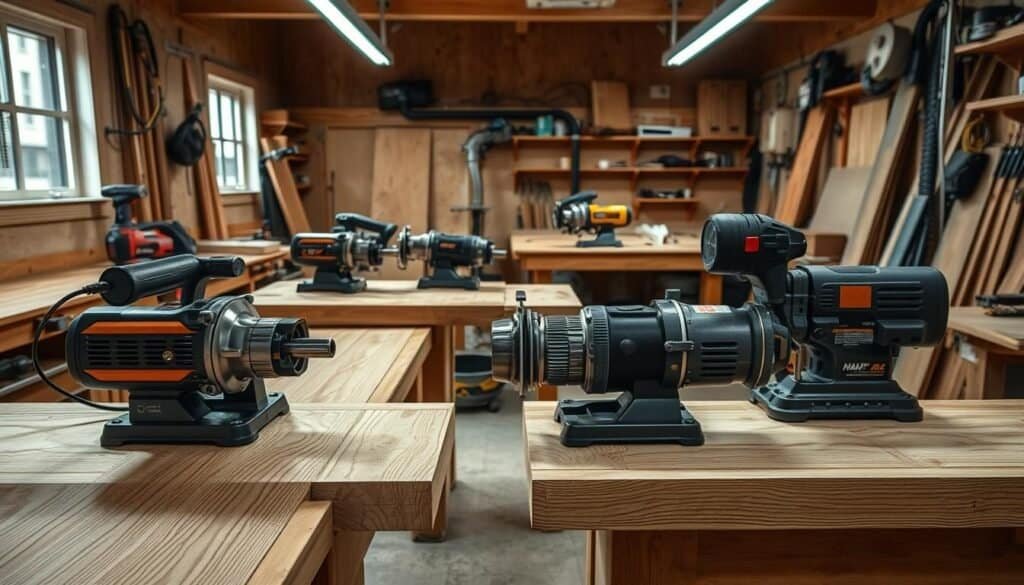
When it comes to routers, following the grain direction is just as important. It prevents chipping and gives you a smoother finish. Choosing the right router bit for your wood and desired look is critical.
Using these power tool setups can take your woodworking to the next level. It doesn’t matter if you’re in a small shop or a big studio. Knowing how to align tools with the grain is a skill worth mastering.
Custom Jigs That Ensure Perfect Grain Alignment
Getting the grain right is key in woodworking. Custom jigs are tools that help woodworkers get it just right. They make sure your projects look professional.
Custom jigs fit your carpentry ideas perfectly. They work for any project, big or small. This makes them a must-have in any woodworking shop.
Template Systems for Repeatable Results
Template systems are a big part of making custom jigs. They help woodworkers get the same results every time. This means less chance of mistakes.
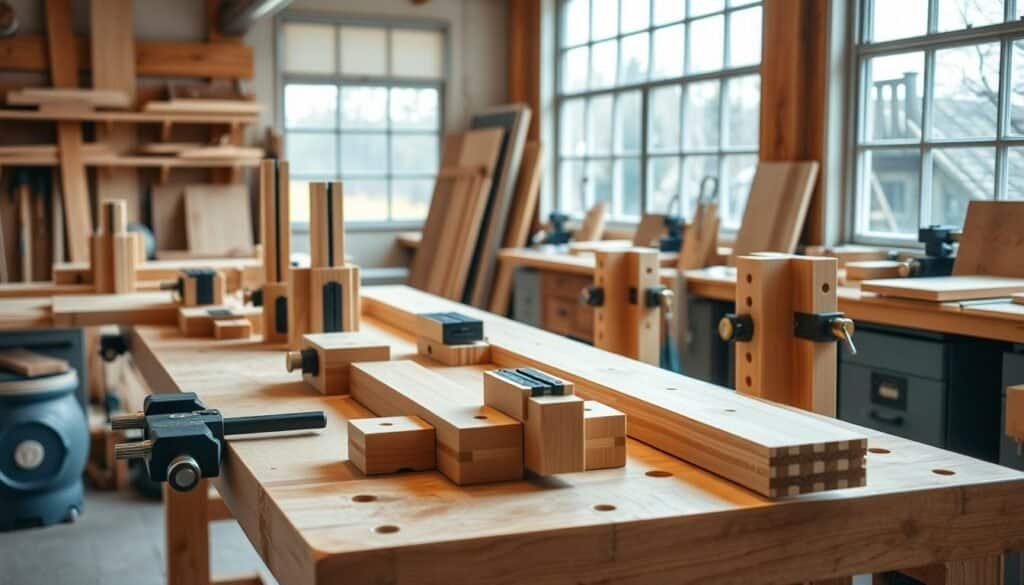
For example, making a jig for a project? Use a template system. It ensures your jig is exact. This means your final product will look great.
In short, custom jigs are essential for perfect grain alignment. Adding template systems to your work makes your projects even better. It raises the quality of your woodworking.
Lumber Selection Strategies Based on Grain Orientation
Grain orientation is key in choosing lumber for woodworking. It affects your project’s stability and look. So, picking the right lumber is important.
First, look at the lumber’s grain patterns. Straight grain lumber is stable and less likely to warp. It’s great for precise projects like furniture. But, lumber with irregular patterns is better for projects that don’t need to be stable, like some DIY projects.

For beginners, learning about grain orientation can be tough. But, it’s very important. Using the right tools can make it easier. For example, a jointer can help make a flat surface, making grain direction easier to see.
When doing DIY or furniture projects, picking the right lumber is key. The right grain orientation can prevent warping or cracking. This ensures your project will last a long time.
Surface Preparation and Finishing Techniques
To make the wood grain stand out, it’s key to know the right steps. Proper preparation and finishing are vital. They help get a smooth finish that highlights the wood’s natural beauty.

First, sanding and smoothing the wood is needed. This makes a good base for finishing. The finishing method you choose greatly affects the project’s look.
Oil Finishes vs. Film Finishes for Grain Enhancement
Oil finishes soak into the wood, making the grain more visible. They give a natural, soft look. For a subtle finish, oil is perfect.
Film finishes, on the other hand, form a protective layer. They make the wood shiny and durable. The choice between oil and film depends on what you want your project to look like.
Joinery Methods Revolutionized by Grain Alignment
Grain alignment is a big deal in woodworking, changing how we do joinery. It makes projects stronger and last longer. Woodworkers can make their work better by aligning wood grain right.
Mortise and tenon joinery gets a big boost from grain alignment. When the grain of both parts is aligned, the joint gets stronger. This is because the wood fibers work together, not against each other.

Dovetailing also gets better with grain alignment. Dovetail joints are known for their strength and how well they resist pull-out. Aligning the grain in the tails and pins makes these joints beautiful and durable.
Grain alignment is also key for dado joints and sliding dovetail joints. In dado joints, it stops the shelf from sagging. For sliding dovetail joints, it makes them work smoothly and last longer.
Adding grain alignment to your joinery methods can elevate your carpentry projects. It’s great for making things for yourself or selling simple wooden crafts. Knowing about grain alignment leads to professional-quality results.
Workshop Organization for Grain-Focused Woodworking
A well-organized workshop is key for woodworking projects that need precise grain alignment. You need a dedicated space for your projects. Tools and materials should be easy to find.
Start by sorting your tools and materials by function and how often you use them. For grain-focused woodworking, having a special area for lumber is important. This lets you check and prepare your wood easily, making sure the grain is right for your projects.
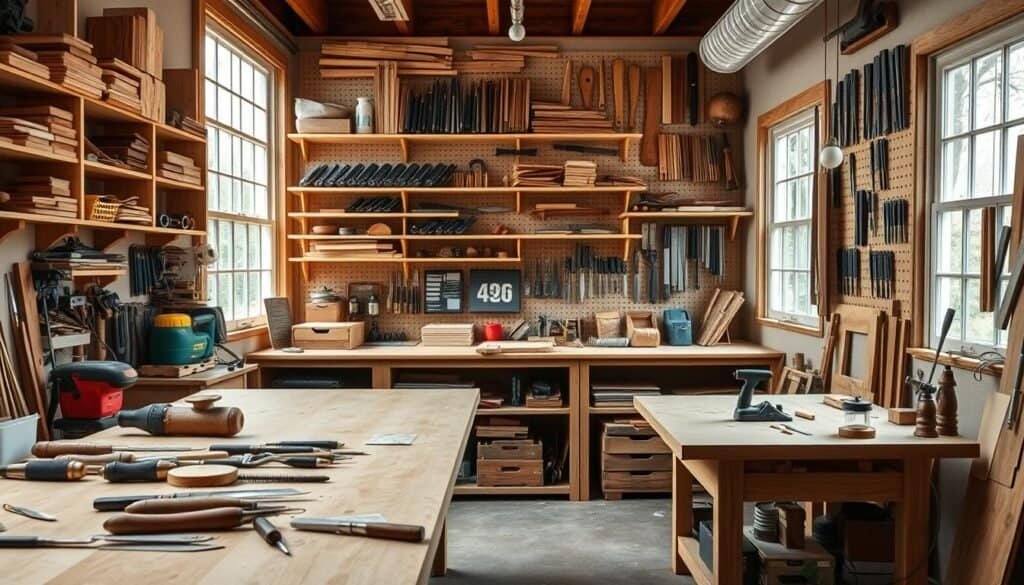
Think about keeping track of your lumber, like the wood type, grain direction, and moisture. This helps you choose the right materials for your projects. Also, having the right tools, like a jointer and planer, is essential for preparing your lumber.
Organizing your workshop for grain-focused woodworking makes you more efficient and effective. You’ll create better projects. This approach also helps you grow your carpentry skills, making you a better woodworker.
Troubleshooting Common Grain-Related Problems
Grain-related issues can be a big problem for woodworkers. But, knowing how to fix them can make a huge difference. Whether you’re working on DIY projects or small woodworking tasks, it’s key to know how to solve grain problems.
Uneven grain can lead to warping or twisting in your project. To avoid this, it’s important to dry and store your lumber right. Using tools like a moisture meter can help keep your wood at the right moisture level.

Grain tear-out is another issue, often caused by power tools. To reduce this, adjust your tool settings or use a sharp blade. For small projects, hand tools with a sharp edge can also prevent tear-out.
Understanding grain problems and how to fix them can improve your woodworking. This knowledge helps you make your projects look more professional, even with small tasks.
Being proactive is also key in troubleshooting. For example, choosing the right lumber for your project can prevent many issues. With the right tools and techniques, you can achieve top-notch results in your DIY projects.
Real-World Projects Transformed by Grain Alignment
Grain alignment in woodworking has made tools more durable and beautiful. It has changed many projects, making them last longer and look better.
Grain alignment is key in woodworking. It makes the wood stronger and longer-lasting. Woodworkers avoid warping or cracking by aligning the grain right.
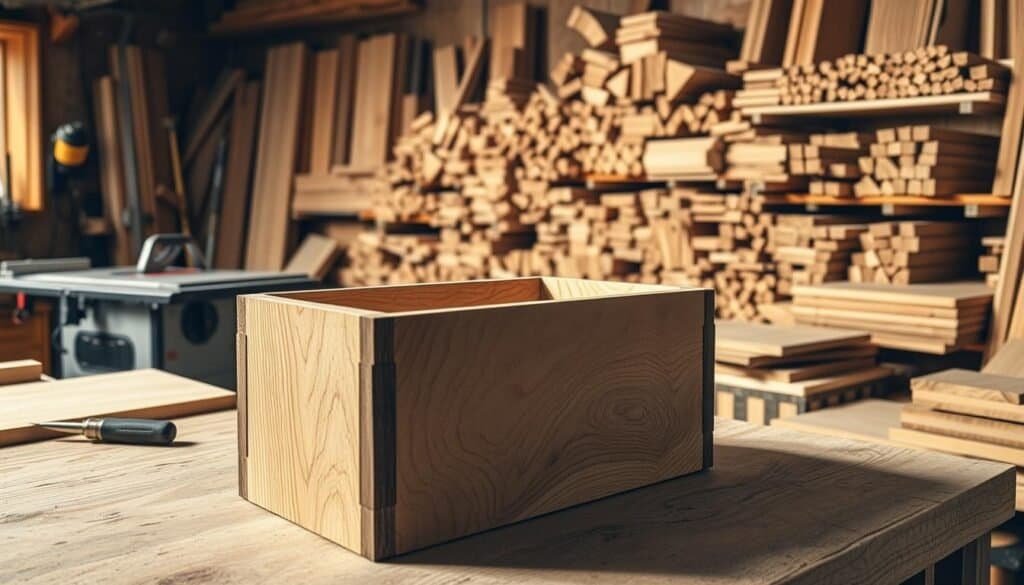
Furniture making benefits a lot from grain alignment. Correct grain alignment makes furniture stable and strong. This is key for big or heavy pieces like tables and shelves.
Grain alignment is also important for making wooden tools and DIY wood projects. It helps craftsmen make tools that work well and last long.
Grain alignment has changed woodworking for the better. It has led to more beautiful, durable, and functional pieces. These pieces show the amazing possibilities of woodworking.
Combining Grain Alignment with Other Woodworking Techniques
Using grain alignment with other woodworking methods is a big leap forward. It’s great for both DIY fans and pro woodworkers. This mix helps make projects look good and last long.
One major plus is how it makes projects last longer. For example, pairing grain alignment with exact joinery makes pieces durable. This is key for DIY projects meant to be useful and last.
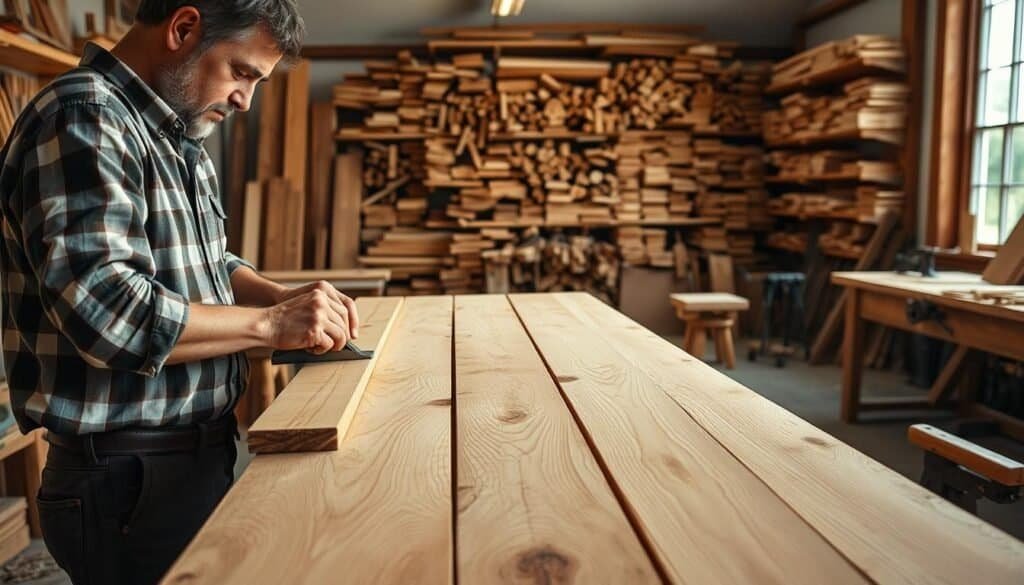
Woodworking jigs are key for getting grain alignment right. Custom jigs for projects ensure precise alignment. This leads to better quality work, making complex and stunning pieces possible.
Also, mixing grain alignment with carpentry ideas leads to unique designs. Whether it’s furniture or decor, the result is more refined. Woodworkers exploring this mix will find new ways to create and improve their craft.
Teaching Grain Alignment to Beginners
Teaching grain alignment to beginners is key in their woodworking journey. It’s essential to know how to work with the wood grain. This knowledge helps in making beautiful and durable pieces.
Beginners should first learn to identify the grain direction. They can do this by looking at the wood’s surface. They should find the lines or patterns that show the grain’s direction.
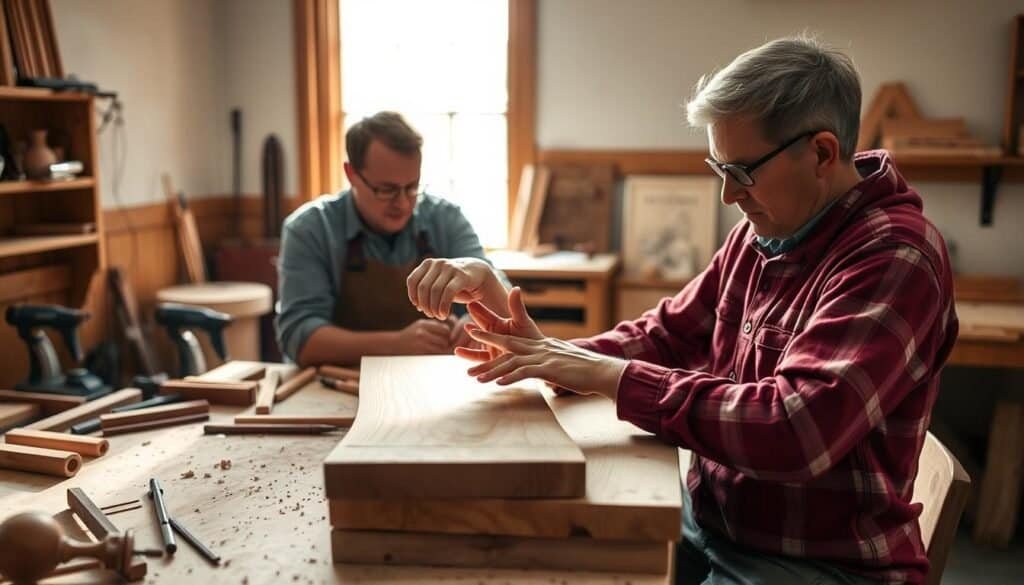
Simple DIY projects can help beginners practice grain alignment. For instance, making a small cutting board or a wooden box. These projects teach them how to align the grain for both stability and looks.
As beginners get better, they can use grain alignment in more complex projects. Like furniture making. Mastering grain alignment lets them create pieces that look professional and are both functional and beautiful.
Advanced Applications for Experienced Woodworkers
Experienced woodworkers can take their skills to the next level by mastering advanced grain alignment techniques. This allows them to create complex woodwork plans that show off their skill and detail.
One key area is in hand tool woodworking projects. Here, precise grain alignment boosts the quality and durability of the piece. For example, aligning the grain right can greatly improve the look and feel of detailed carvings or joinery.
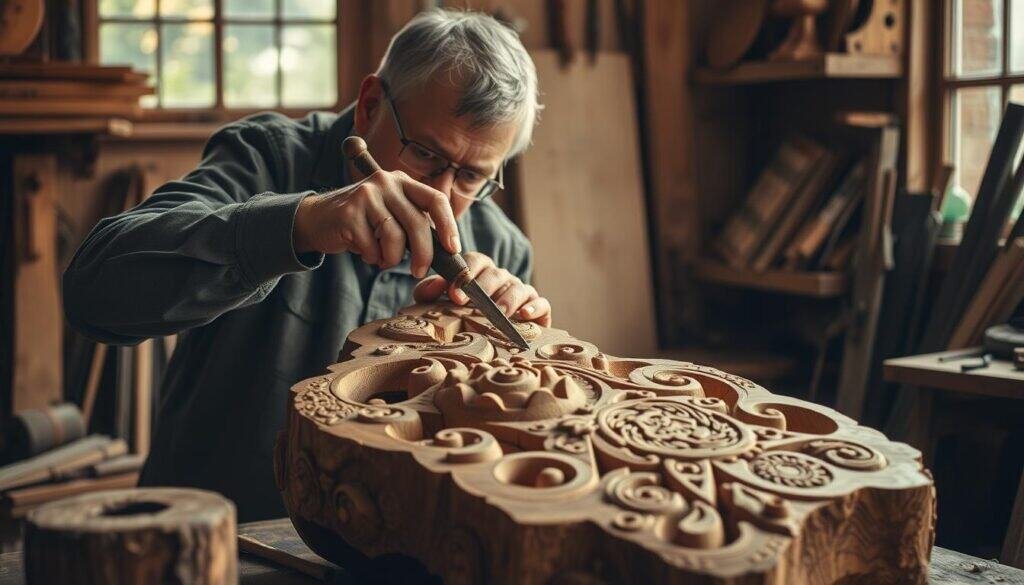
Experienced woodworkers can also apply grain alignment to jigsaw projects. This ensures the cut patterns and designs are not just pretty but also strong. This focus on detail can turn a simple project into a work of art.
By learning these advanced techniques, woodworkers can tackle more complex projects. This lets them explore new possibilities in their craft.
Conclusion: Revolutionizing Your Woodworking Journey
As we wrap up our look at a secret woodworking tip, it’s clear that grain alignment is key. It makes your DIY woodworking projects better and last longer. By learning and using this method, you can make your woodworking much stronger.
We’ve covered a lot about grain alignment in this article. We talked about how it affects your project planning and how to use it in different joinery methods. Adding this secret to your skills lets you take on more challenging projects with ease.
Remember, mastering grain alignment is just the start. By combining it with other woodworking skills, you’ll open up new possibilities. Whether you’re experienced or new to woodworking, success comes from trying new things, practicing, and being open to learning.
By using grain alignment, you’ll not only make your woodworking better but also enjoy the process more. So, get ready to change your woodworking journey. You’ll create beautiful and lasting pieces.


